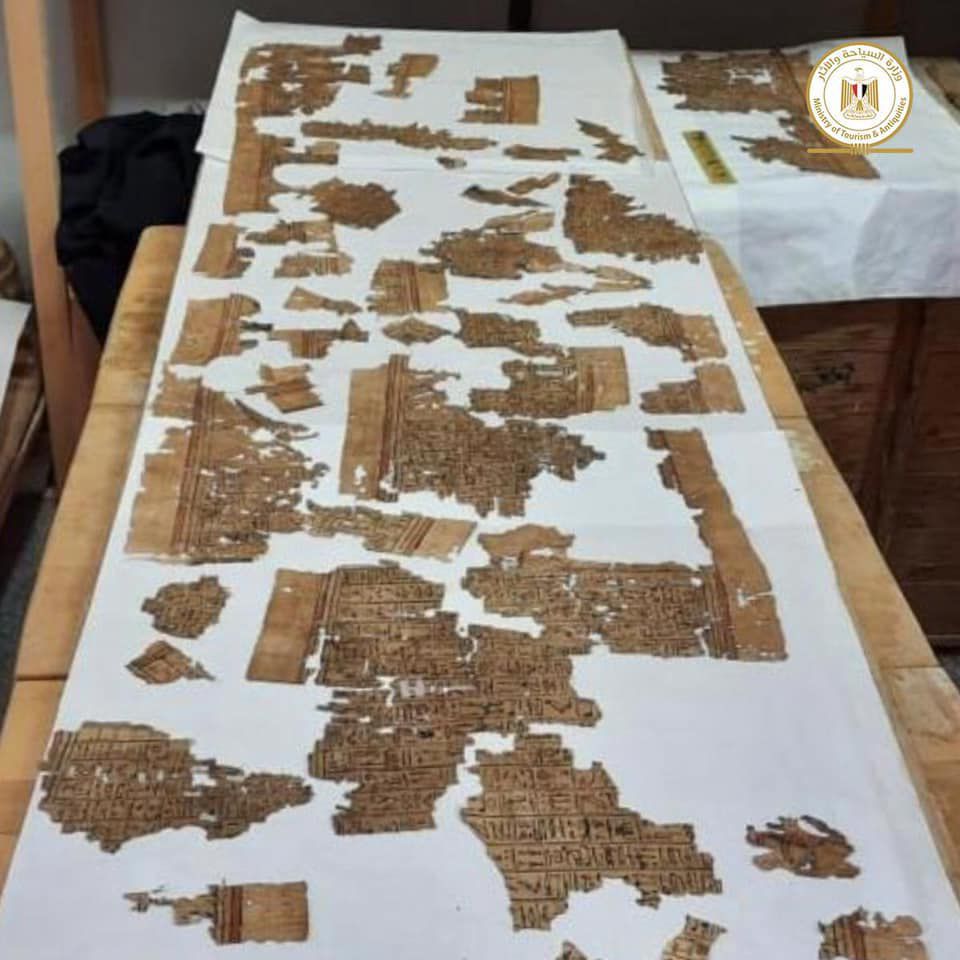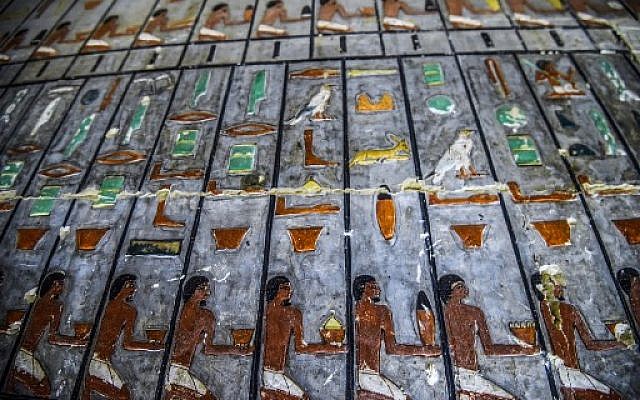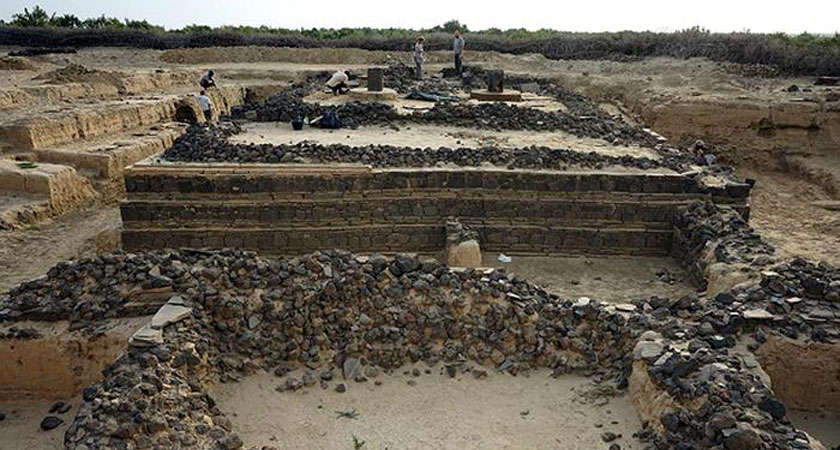Recent Archaeological Discoveries
 |
At Saqqara, Egyptian archaeologists found 50 wooden coffins, a 13-foot-long Book of the Dead scroll, a model boat, and other artifacts dating to the New Kingdom (1570-1069 BC). Although the site was originally excavated in 2010, archaeologists only recently linked it to 6th Dynasty Queen Naert, the wife of King Teti (2680-2180 BC). Read More.
2020
27 Coffins at Saqqara
Egyptian archaeologists uncovered 27 decorated sarcophagi and other artifacts from two different wells located at Djoser's Pyramid at Saqqara. Although the pyramid is the world's oldest, dating to roughly 2670 BC, the newly discovered coffins only date to the Coptic era under Persian rule (roughly 500 BC). Read More.
Vast Funeral Industry at Saqqara
Although discovered in 2018, the 'funeral home' or mummification workshop at Saqqara (600 BC) has only recently revealed the extent of the funeral industry in ancient Kemet. In addition to large incense burners, blood drainage channels and a ventilation system, archaeologists found mummified remains, coffins, and urns prepared using various methods and materials, suggesting ancient undertakers offered different embalming methods and funerary products for different budgets. Read More.
2019
Oldest Known Christian Church in Ethiopia
Archaeologists unearthed the remains of the oldest known Christian church in Ethiopia, built in the 300s AD some 30 miles north of the ancient capital of Aksum. The main structure of the 60x40 ft church, built in the style of a Roman basilica, a gold ring with a bull's head, and a stone penant with Ge'ez writing, were the most important finds. Read More.
30 Colored Coffins at Luxor
Egyptian archaeologists dug up 30 colored tombs at the Al-Asasif cemetery near Waset (Luxor), the largest such find in a century. The coffins belonged to male and female priests and children under the 22nd Dynasty (945-720 BC). Read More.
Storage Buildings at Ramses II's Fortress
Two square-shaped, mud brick buildings apparently used to store food were identified by Egyptian archaeologists at Ramses II's fortress (1279-1213 BC), north of Cairo, Egypt. Excavated were pottery, animal and fishbones, and grains that had been roasted, representing a method of food preservation different from the more common salting, fermentation, drying and smoking. Read More.
 |
The tomb of a high official named Khewi (or Khuwy) who served during the 5th Dynasty (2465-2323) was found at Saqqara. The tomb features numerous inscriptions and depictions, including Khewi seated at an offerings table above large sailing ships. Read More.
Medieval Stone City in South Africa Larger than Thought
Laser technology assisted archaeologists in determining the size of the medieval stone city of Kweneng near Johannesburg. The stone ruins are spread over an area of about 8 square miles (20 sq km) and was thought to be inhabited by as many as 10,000 people at its height (1400-1820). Read More.
2018
Sandstone "Sphinx" in Nubia
Egyptian archaeologists unexpectedly found a standstone horemakhet (sphinx) statue while attempting to decrease ground water at the temple of Kom Ombo in Nubia. This is the same site where archaeologists had earlier found 2 sandstone statues of Ptolemy V (204-180 BC). Read More.
Ancient Pregnancy Test
The University of Copenhagen acquired 1400 ancient Kemetic papyrus texts, including instructions on testing pregnancy and fetal gender, treating eye diseases and descriptions of the anatomy. The texts are written in the Hieratic script and date to the New Kingdom (1500-1300 BC). Read More.
 |
The ancient Aksumite port of Adulis, on Eritrea's Red Sea coast, was identified by a team of Eritrean and Italian archaeologists. The remains of numerous stone structures in a typical Aksumite style, dating to the 600s AD, were found buried under the desert sands. Read More.
Portrait of Hatshepsut at UK's Swansea University
Limestone fragments of a portrait of Hatshepsut (18th Dynasty, 1507-1458 BC) were found in Swansea University's archives. The fragments are believed to be from a wall at Hatshepsut's temple at Deir-el Bahri near Waset. Read More.
2017
Ancient Carpentry Workshop on Elephantine Island, Egypt
Archaeologists located a carpentry workshop on Elephantine Island in the Nubia region of Egypt. Dating to the 18th Dynasty (c. 1550-1292 BC), the workshop was replete with various tools, such as two axes with wooden handles that bear similarity to those found in Syria. Read More.
Oldest Evidence of Domesticated Sorghum in Eastern Sudan
Analyses of plant impressions left on pottery sherds excavated at Kassala, Sudan revealed evidence that ancient Kushites ("Butana Group" culture) domesticated sorghum as early as 3500 BC. The find sheds further light on the prevalence of agriculture in the Nile Valley. Read More.
3,000-year-old Petroglyph with Symbols in Namib Desert
Archaeologists found stone engravings of an antelope or kudu, surrounded by various symbols in the Namib desert, which spans 1,200 miles of the southwest African coastline. Investigations of customs of local groups indicate the image might relate to female initiation rituals long practiced in the region. Read More.
1,000-year-old Remains of Medieval City of Harlaa, Ethiopia
In Northeast Ethiopia, archaeologists uncovered the remains of a stone mosque from the 1100s AD, a large cemetery, jewelry and other artifacts from Egypt, India, China, Madagascar and the Yemen. The discovery sheds light on the city's connection with Indian Ocean trade networks. Read More.
Hoard of Glass Beads in Medieval Ile-Ife, Nigeria
Researchers unearthed nearly 13,000 1,000-year-old glass beads of various colors, shapes and sizes at the ancient Yoruban city of Ile-Ife, which has become famous for its copper and terracota sculptures. In addition to the beads, crucible and ceramic cylinder fragments, pottery sherds and glass waste were also found, indicating the close proximity of a glassmaking workshop. Read More.
Ancient Rock Art in Southeastern Botswana
Second only to the Sahara region, southern Africa is the world's largest repository of ancient rock art. However, recent direct radiocarbon dating of sample organic materials used in paintings from the Thune Dam in Botswana, the Phuthiatsana Valley in Lesotho, and the Maclear District in South Africa reveal they were likely made between 5723-4420 BC. Read More.
4,000-year-old remains of Temples Near Ancient City of Kerma, Sudan
Near the remains of the ancient city of Kerma, archaeologists uncovered three large structures at Doukki Gel in Sudan. Believed to be temples, the ovular structures appear to be architecturally diffrent from others found both at Kerma and elsewhere in the Nile Valley. Dukki Gel is also the site where the same archaeologists had previously found massive structures they described as fortresses. Read More.
Ancient People in Ghana Used Asian Plants
DNA analyses of residue in terracota figurines unearthed several years ago at the Yikpabongo archaeological site in northern Ghana revealed the presence of non-native species, banana and pine. The find not only suggests this region of Ghana was connected to international trade networks, but that these exotic plants were likely used in rituals. Read More.
Continue >>
